 “The ceiling of the regime is too low for me to stand!“ This lament by an elderly Libyan man in a bitter reference to the Qaddafi era struck me deeply. [National Geographic, February 2013]
“The ceiling of the regime is too low for me to stand!“ This lament by an elderly Libyan man in a bitter reference to the Qaddafi era struck me deeply. [National Geographic, February 2013]
I imagined a proud and capable man bent low beneath the oppression of that petty and dangerous regime. [A ceiling in place from 1969 to 2011, nearly the span of my lifetime.] Rather than being able to stand tall, breathe freely and live into a full and satisfying life, this man was forced to live hunched and constrained.
In my work with leaders I often refer to the ceiling they create for themselves, their teams and business. This ceiling reflects the limits the leader sets on those around, often unconsciously. In principle, the lower the ceiling, the lower the potential performance and happiness.
People beneath a ‘low ceiling’ leader, particulary within organisations, understand intuitively the dangers in out performing them. A few may rebel and be crushed, most comply to survive, others resign and flee. None of this activity creates an environment of high achievement, growth and success.
Leaders inevitably shape an organisation as a product of their own vision and awareness. This implies an important leadership imperative, the need for constant self development and evolution. If you stagnate, so will your team; and as you expand your horizons, so your organisation is enabled to expand and extend.
In the new Libya, may this Berber man now stand taller.

